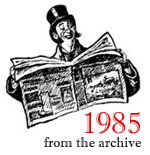
John Cassavetes & the Mystery of Moviemaking
A CINEMATIC VIEW
I have to admire John Cassavetes even when I become angry at him — and I become angry at him each time I see one of his films! His latest creation, Love Streams, is a typical Cassavetes opus: at times a beautiful blend of intuition, sensitivity, and compassion, but at other moments a maddening mixture of overly long scenes, aimless dialogue, and a seemingly directionless plot.
An individualist who refuses to surrender to the system, Cassavetes has been directing highly personal films (most of which he authored) for more than 20 years. If you wonder where the authentic artist is in movieland in the 1980s, the artist who refuses to change his perspective or alter his technique for monetary gain, you don’t have to look past John Cassavetes. There is not a compromising shot in a Cassavetes film, not a dishonest bit of dialogue, not a moment of cheap manipulation of the viewers’ emotions.
Using a hand-held camera without a script, Cassavetes improvised with a group of protégés and created his first film, Shadows (1961). A piece of classic cinéma vérité, the film won the Critics’ Award at Venice. Shadows illustrates the kind of personal style of moviemaking — highly improvisational, wrenchingly realistic, loosely edited, strongly intuitive — that Cassavetes has continued right up to Love Streams. In films such as Faces (1968), Husbands (1969), A Woman Under the Influence (1974), and Gloria (1980), Cassavetes has explored the human condition with enormous compassion.
Obviously in love with his characters and probably also with the actors and actresses who portray them, Cassavetes in his filming often seems to become part of the audience: he allows scenes that begin marvelously to go on too long. Not exercising control, Cassavetes lets his stories ramble, and so the theme of a plot can be obscured.
You May Also Enjoy
Anglophone societies might not be the direct heirs of the French Revolution itself, but they have been infected by its Jacobin social pathologies.
A kernel of nihilism undoes whatever meaning modern men try to inject into their own lives.
Herb Meyer argues that Western Civilization is the best (earthly) thing to have happened to humanity, and is well worth defending.

